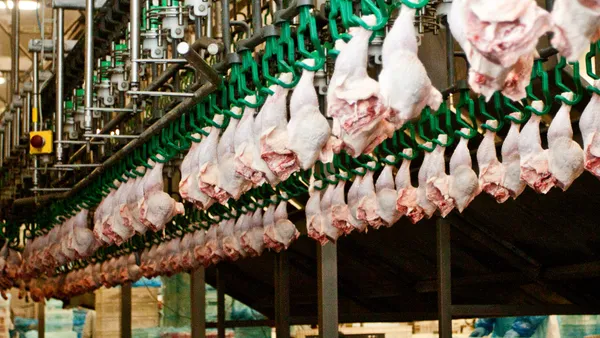Dive Brief:
- As the U.S. Department of Agriculture’s rule for updating school nutrition standards is set to go into effect July 1, the finalized regulation is expected to cost school districts an extra 3 cents per meal on average, according to a recent Congressional Research Service report. That adds up to about $206 million every year nationwide.
- The USDA’s approved changes include new limits on added sugars and sodium in school meals, which are the largest driving costs in the rule, the Congressional Research Service said. Specifically, the added sugars policy will cost schools $110 million and the sodium reductions will cost $86 million annually.
- While there is currently no federal funding to help schools implement this rule, the Congressional Research Service pointed out that the USDA has cited several available federal resources — including its Healthy Meals Incentives initiative and the Patrick Leahy Farm to School Grant Program — when the agency announced its final rule.
Dive Insight:
Though the USDA’s rule will officially start rolling out in several weeks, the gradual changes to school meals will not begin until 2025, and the regulation will not have to be fully implemented until fall 2027.
Starting in fall 2025, the new added sugar limit will be required for flavored milk, which will not be allowed to contain more than 10 grams of added sugar per 8 fluid ounces. Breakfast cereals will not be permitted to have more than 6 grams of sugar per dry ounce as of July 1, 2025.
By the 2027-28 school year, a weekly dietary limit will be in full effect, requiring that added sugars make up less than 10% of calories during the week in school breakfast and lunch programs.
Schools will have to decrease sodium levels by 15% in lunches and 10% in breakfasts starting July 1, 2027.
The changes to school meals come as the Biden administration has made it a priority to improve children’s health, as outlined in the National Strategy on Hunger, Nutrition and Health released in September 2022 during a White House conference on the topic.
The USDA pared down several of its initial proposals to school meal nutrition standards since it first announced it was considering a rule. For instance, the USDA initially suggested that schools be required to offer mostly whole grain products, but that requirement did not make it into the final rule.
The agency’s shift from some of its stricter proposals made the approved, gradual changes “more attainable,” the School Nutrition Association said in an April statement when the USDA announced its final rule.
The Congressional Research Service’s estimates of the rule’s financial impact back up SNA’s previous concerns that there will be notable rising costs affiliated with the new requirements. The association has also urged Congress and the USDA for more support to schools in order to properly implement the upcoming nutrition updates.
The USDA also expects the new regulation to average $16 million nationally in annual administrative costs that are mainly tied to “shifts in purchasing patterns and increased labor costs,” the Congressional Research Service reported.












